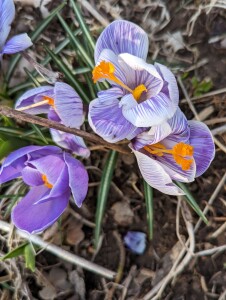 Where would we be without crocuses? They are not always the first flowers to bloom in the spring—snowdrops and winter aconite do that. But they are uniquely joyful and welcoming. Combine that with the fact that they are cheap and easy, as in cheap to buy and easy to grow, and you have excellent plants that should be in every garden.
Where would we be without crocuses? They are not always the first flowers to bloom in the spring—snowdrops and winter aconite do that. But they are uniquely joyful and welcoming. Combine that with the fact that they are cheap and easy, as in cheap to buy and easy to grow, and you have excellent plants that should be in every garden.
I need whimsy in my life right now, and I suspect that I am not alone. Whimsy at this moment means striped flowers, and striped crocuses fill the bill nicely, brightening a mood that will eventually be further elevated by striped tulips, wildly patterned pansies, and striped roses.
But I will not get ahead of myself. Living in the moment requires attention to what is right in front of me, or, in this case, in front of my house. The ground in my front beds is sprinkled with two of my favorite striped varieties, ‘King of the Striped’ and ‘Pickwick’. The former sounds regal, while the latter sounds whimsical. It doesn’t matter, they both look whimsical. I also grow ‘Gypsy Girl’, which are little gold and maroon-striped snow crocuses, They bring their own kind of joy, but for the perfect combination of the rambunctious, the whimsical and the festive, nothing is better than purple and white, or purple and mauve striped crocuses.
Some people find the larger works of Charles Dickens tedious, but even they might enjoy The Pickwick Papers a charming book about the Pickwick Club, a group of men who amuse themselves by exploring interesting or curious places or events. Samuel Pickwick is the eponymous founder of the club, and ‘Pickwick’ the crocus is named for him. The book came out in 1836 and the crocus arrived on the scene about 1875. It is hard to imagine a crocus that would bear any resemblance to Mr. Pickwick, who was distinguished by his large bald head and gullible nature. However, the book is light-hearted and fun, which defines ‘Pickwick’ the crocus.
It was fashionable in Victorian circles to call particularly fine plant varieties the “king” or “queen” of something or somewhere. I have an heirloom hyacinth that was dubbed ‘King of the Blues’, for its rich color. ‘King of the Striped’, which came out about 1885, is big and bold, as crocuses go, and its purple stripes hearken back to the traditional color of royalty.
Both ‘King of the Striped’ and ‘Pickwick’ inhabit my garden, and at this point, having grown them for years, I really can’t distinguish between them. They are varieties of the large-flowered Crocus vernus—“large” in this instance meaning bigger than the little species crocus, like Crocus chrysanthus or snow crocus. Sometimes also called “Dutch crocus”, they boast upright flowers that are chalice-shaped in bud, opening out into six-petaled bowls. The petals’ background color is white or palest lilac, while the stripes and veins are medium to dark purple. The anthers in the middle of each flower are orange-gold, creating a glorious contrast.
Crocuses, like other beautiful creatures, need their beauty sleep, which is why they fold up their petals when darkness falls, and reopen them each morning.
Crocus foliage is narrow and grass-like, barely noticeably most of the time. It hangs around after the blooms have finished, but disappears as early summer sets in. Since the foliage is relatively inconspicuous compared to the long leaves of daffodils and tulips, garden aesthetics are undisrupted by allowing the leaves to ripen and gradually fade away. It is a good idea to photograph or mark the spots where the crocuses reside so you don’t inadvertently dig up the bulbs later in the season.
As everyone knows, in order to enjoy crocuses at this time of year, you have to plant them in the fall. Fortunately, online merchandisers will start listing their fall bulbs in the next few weeks. You can order now for September or October delivery, which means that you don’t have to remember to make the order at the end of your summer vacation or the beginning of the busy fall season. Vendors also tend to offer discounts to early orderers, which is nothing to sneeze at in inflationary times.
Deer and other varmints may or may not sneeze at crocuses, but they tend to avoid them. The little bulbs can also tolerate and make their way through sticky clay soil and are immune to the toxins secreted by black walnut trees. In fact, a mass of crocuses looks wonderful under any deciduous tree. They are also great in containers, especially if you use the container-within-a-container approach, and lift out the inner, crocus-filled container when the blooms fade. Alternately, you can sow the seeds of annuals, like cosmos or marigolds into the soil around the fading crocuses. By the time the annuals sprout, the crocuses will be going to sleep.
Some vendors offer another, earlier-flowering bi-colored crocus, ‘Spring Beauty’, which features flares of dark purple on a mauve background. ‘Spring Beauty’ lives up to its name, but at the moment I prefer stripes to flares, and the piquancy of ‘Pickwick’ and ‘King of the Striped’.
Find ‘Pickwick’ and other lovely spring bulbs at John Scheepers, 1 Tulip Drive, Bantam, CT 06750; (860) 567-0838; www.johnscheepers.com. ‘King of the Striped’ is available at Old House Gardens, 4175 Whitmore Lake Road, Ann Arbor, MI 48105; (734) 993-1486; www.oldhousegardens.com. Both vendors offer print catalogs.
|
|
